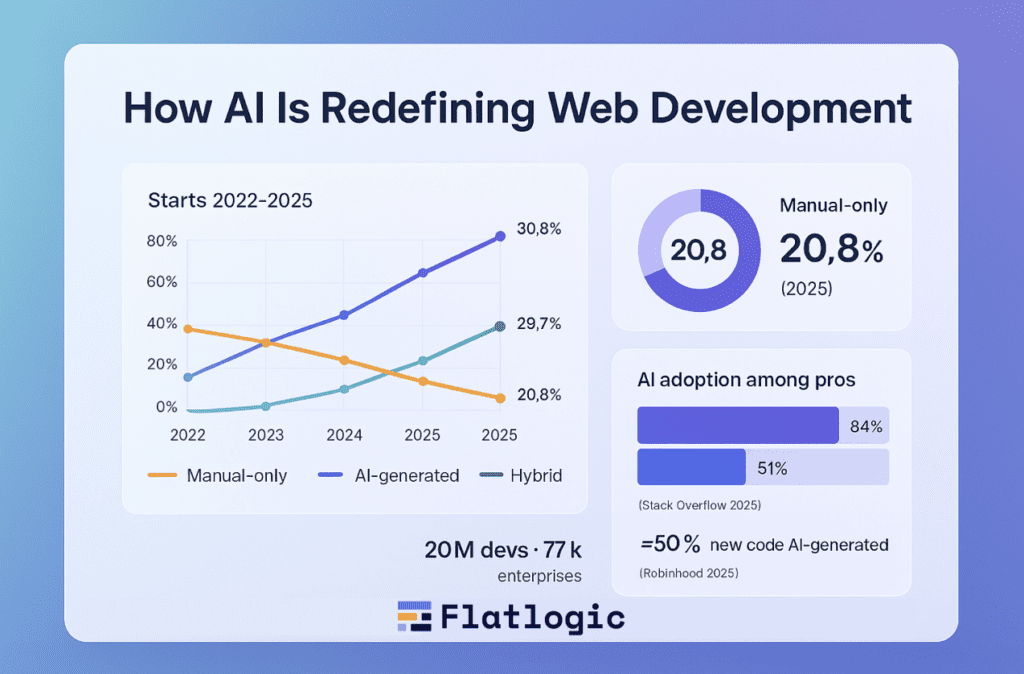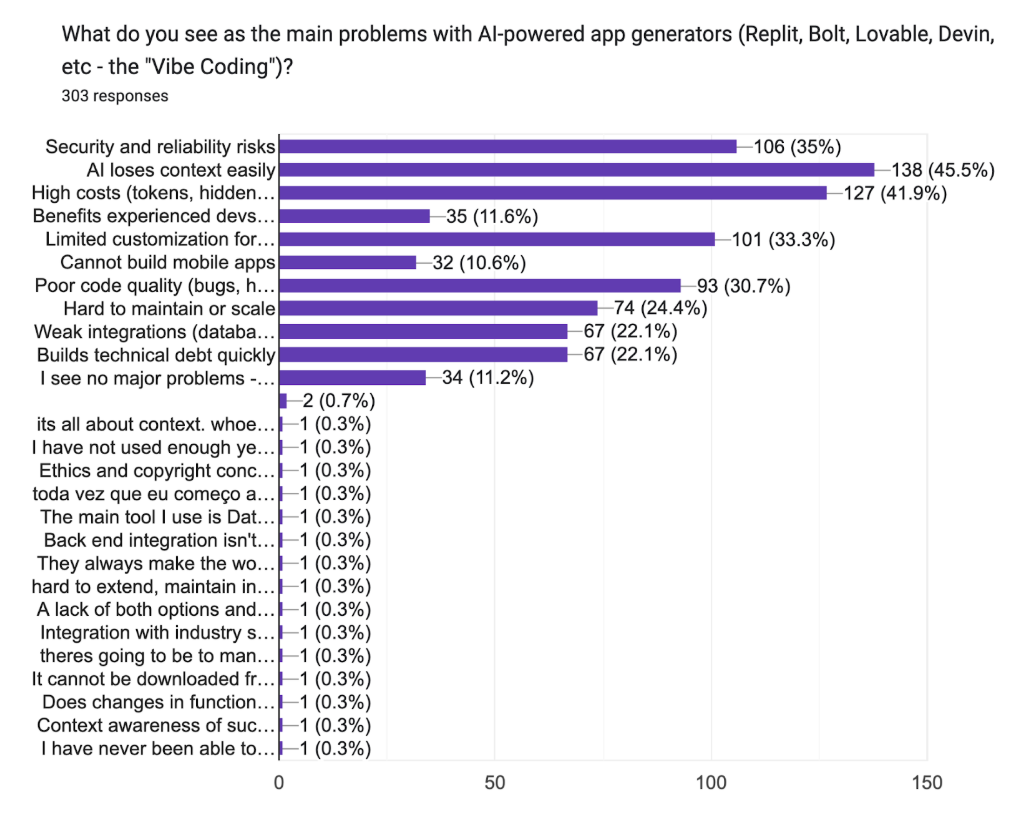TL;DR
- Manual-only coding is rapidly declining as AI-generated code becomes standard in web development.
- Flatlogic’s 2025 data: AI app generators lead starts; manual-from-scratch down to 20.8%.
- Developers shift from typing code to supervising systems; speed rises, but governance and context are critical.
- Teams adopting AI-first, hybrid workflows ship faster; laggards risk falling behind.
Fact Box
- Only 20.8% of new web apps start entirely from scratch by humans in 2025. Source
- AI app generators are the starting point for 38% of new web projects. Source
- 29.7% of teams use a hybrid approach, combining AI-generated code with manual customizations. Source
- 14.5% report reaching production-grade (L5) apps using primarily AI-generated foundations. Source
- 84% of professional developers use or plan to adopt AI-powered tools. Source
Manual coding isn’t just fading away, AI is actively replacing it. If you’re still hand-writing every line of code, you’re playing yesterday’s game. Keep reading, because this shift is already transforming web development as you know it.
When considering using AI in software development, you’re probably wondering: Can AI-generated code match human quality? How much faster can AI tools truly make development? What are the risks involved when relying on AI-generated codebases? And crucially, how do you safely transition your team to an AI-driven workflow? As GitHub CEO Thomas Dohmke put it bluntly in 2025: “Within the next few years, more code will be generated by AI than written by humans.”
The reality is that manual-only coding is shrinking rapidly: According to Flatlogic’s comprehensive “Starting Web App in 2025” research, only 20.8% of web applications are now started entirely from scratch by humans, a staggering drop from previous years. This means companies clinging to manual development practices risk being outpaced by competitors leveraging AI’s speed and productivity.
By reading this article, you’ll clearly understand why manual coding is giving way to AI, what this means for your projects and career, and how to practically leverage AI coding tools to keep your development process competitive, efficient, and future-proof.
How AI Is Redefining Web Development

Web development is undergoing a dramatic shift. The industry is moving away from manually coding every line of code and toward an AI-driven model. In this model, developers supervise and refine code generated by intelligent tools. By 2025, this won’t be experimental; it’ll be the norm. According to Stack Overflow’s latest survey, 84% of professional developers currently use or plan to adopt AI-powered tools, with over half using them daily. This is a clear sign that the industry is pivoting toward automation and efficiency.
Leading companies are embracing the change. GitHub reports that 20 million developers at 77,000 companies regularly use AI coding tools, and nearly half of their new code is generated by AI. Nearly all of their engineers rely on AI editors. Flatlogic’s “Starting Web App in 2025” study reflects this trend, revealing that manual coding accounts for only 20.8% of new web app development. AI app generators have become the most common starting point. 
This isn’t about replacing engineers but elevating them. Instead of burning hours on boilerplate, developers are shifting to higher‑order work, guiding AI output, safeguarding architecture and security, and managing complexity.
In 2025 and beyond, the job of a developer is no longer “typing every line” but “supervising intelligent systems.” Those who adapt will unlock unprecedented speed and innovation; those who don’t risk being left behind.
Inside the Numbers: Flatlogic’s 2025 Research on AI in Web Development
Flatlogic’s annual “Starting Web App in 2025” research offers compelling evidence of how dramatically AI is reshaping the way developers build web applications. Conducted from April to July 2025, the study collected insights from 303 software professionals across 33 countries, providing a detailed look at the changing landscape of web development practices.
The Rapid Decline of Manual Coding

The study reveals that the share of web applications built entirely by hand has plunged significantly, from 65.9% in 2022 to just 20.8% in 2025. This striking decrease underscores a fundamental shift away from manual coding towards more efficient, AI-driven development methods.
AI-Driven Tools Take the Lead

For the first time, AI-powered app generators, such as Flatlogic, Bolt.new, and Lovable, have become the most common starting point for new web apps, accounting for 38% of all projects. Additionally, 29.7% of respondents indicated they use a hybrid approach, combining AI-generated code with manual customizations. Notably, traditional low-code/no-code platforms have dramatically fallen in popularity, now representing only 6.3% of web app starts.
Beyond Prototypes: AI in Real-World Production
A common skepticism toward AI tools is their capability to deliver production-ready apps. Flatlogic’s research addresses this directly: 31.7% of developers reported successfully using AI-generated code to build frontend applications integrated with external backends (L3 apps), while 29.4% achieved fully custom, full-stack CRUD applications (L4 apps). Perhaps most impressively, 14.5% claim they’ve reached true production-grade apps (L5 apps) using primarily AI-generated foundations, clearly indicating the maturity and real-world viability of AI-driven development.
Challenges and Concerns in AI Adoption

The study doesn’t overlook hurdles. Developers identified several key issues when integrating AI-generated code into professional workflows:
- Context Loss (45.5%): Difficulty maintaining clarity and consistency across generated codebases.
- Pricing Opacity (41.9%): Uncertainty surrounding the cost structure and predictability of AI-based services.
- Security & Reliability Concerns (35%): Worries about vulnerabilities or flaws inherent in generated code.
- Limited Customization (33.3%): Challenges in extensively modifying AI-generated code to meet highly specific project needs.
However, it’s worth noting that 11.2% reported encountering no significant barriers, highlighting that effective adoption strategies can mitigate these issues.
Persistent Tech Preferences
Despite AI’s transformative role, certain technological preferences remain steady. React continues to dominate frontend frameworks, chosen by 43.75% of respondents. Java remains prevalent on the backend, slightly ahead of serverless solutions, while AWS remains the most popular cloud provider. Tailwind CSS has surpassed Bootstrap, reflecting the ongoing evolution of design practices. Importantly, these enduring tech stack preferences shape the nature of AI-generated outputs, reinforcing the need for generators that align with industry standards.
This detailed data from Flatlogic paints a clear picture: AI isn’t just influencing web development, it’s leading it. Understanding these insights helps teams and decision-makers confidently navigate the emerging AI-driven era.
What “manual coding is dying” really means (and what it doesn’t)
AI’s rapid adoption raises important questions: Will AI replace web developers entirely? Are engineers becoming obsolete? Not exactly. Instead, what’s changing fundamentally is the nature of a developer’s role, from code author to system supervisor, architect, and curator of intelligent output.
Tasks AI is Rapidly Taking Over:
- Routine boilerplate: CRUD scaffolds, standard authentication layers, repetitive data-handling code.
- Automated testing: Unit test templates, basic coverage, and initial validation checks.
- Simple integrations: Basic API connections, service hooks, and standard libraries setup.
Tasks That Remain Deeply Human:
- Architectural design: High-level system structure, data modeling, performance optimization, and scalable infrastructure.
- Security & compliance: Risk assessment, penetration testing, ensuring regulatory adherence.
- Complex customizations: Specialized features requiring domain-specific knowledge, deep business context, or creative problem-solving.
New Skills Developers Must Master:
- Prompt engineering: Precisely instructing AI models through structured input (“contract prompts”), anticipating how AI interprets requirements, and providing iterative guidance.
- AI debugging: Rapidly identifying and correcting faulty AI-generated code or logic errors through efficient reviews and refactoring.
- Context & knowledge management: Maintaining project clarity through structured documentation, glossaries, architectural decision records (ADRs), and clear coding standards.
In other words, the rise of AI doesn’t eliminate the developer role, it transforms it into something more strategic, creative, and influential. Engineers who embrace this shift position themselves as powerful orchestrators, multiplying their productivity and impact significantly.
The Contrarian View: AI Could Make Bad Teams Even Worse
AI-driven web development isn’t automatically a silver bullet, it’s a multiplier of your existing strengths and weaknesses. While Flatlogic’s research clearly shows widespread productivity gains, it also reveals critical issues. Without a clear strategy, AI can accelerate poor decisions and deepen existing technical debt.
Common Pitfalls of Unstructured AI Adoption:
- Accelerating tech debt: AI can generate flawed code quickly. If your current workflow lacks robust code reviews, testing, or security practices, AI will compound these issues rapidly.
- Context fragmentation: Teams that neglect documenting decisions or defining clear architecture risk severe fragmentation when AI continuously generates inconsistent or misaligned code.
- Skill erosion: Over-reliance on AI may diminish developers’ deep coding skills and systems understanding, weakening their ability to handle complex, unexpected scenarios.
The Real Risk: Mismanagement, Not AI Itself
Stack Overflow’s 2025 Developer Pulse survey describes many developers as “willing but reluctant” when it comes to AI tools. Their reluctance is rational: mismanaged AI use amplifies chaos, not clarity. To mitigate these risks, organizations must invest in clear governance, structured workflows, and continuous developer education.
AI’s greatest promise lies not in replacing developers, but in amplifying disciplined practices. Teams must be cautious not to confuse automation with intelligence; it’s your strategic rigor, not AI alone, that determines success.
Conclusion: Manual Coding Isn’t Dead – It’s Just No Longer the Smart Way to Start
We’ve reached a tipping point: manual coding isn’t dead, but it’s clearly no longer the optimal way to build web applications from scratch. Flatlogic’s 2025 research and broader industry data show undeniable evidence: the future belongs to those who combine the best of AI-driven speed with human strategic insight.
Teams embracing this hybrid, AI-first development approach are shipping faster, innovating more effectively, and setting new industry standards. Those who stubbornly stick to manual-only methods risk irrelevance in an accelerating marketplace.
The smartest move now is simple: experiment with AI-driven workflows, validate them practically, and see firsthand if they enhance your team’s productivity and effectiveness. Platforms like Flatlogic offer concrete examples and real-world data that can help guide your decision, not as a sales pitch, but as proof of what’s already possible.
The teams that thrive won’t be writing every line manually, they’ll be supervising intelligent systems and leveraging automation to multiply their impact.
The next move is yours.
Comments